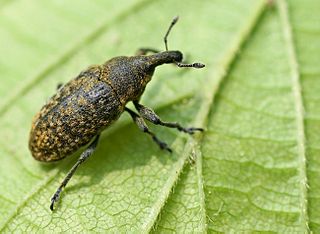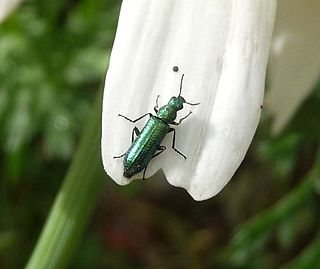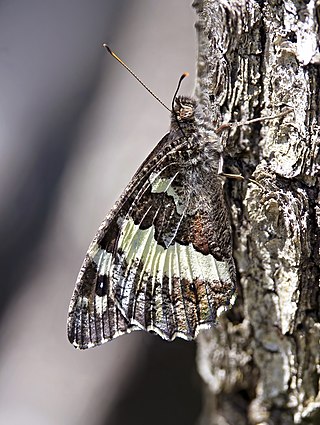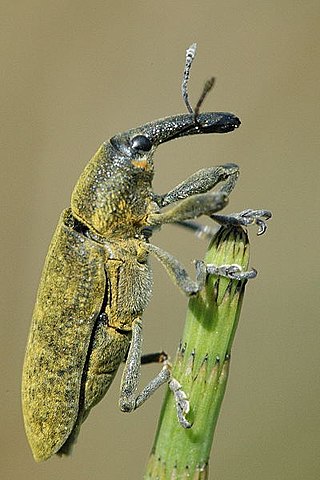
The lime-speck pug is a moth of the family Geometridae. It is a common species throughout the Palearctic region, the Near East and North Africa.

Cirsium arvense is a perennial species of flowering plant in the family Asteraceae, native throughout Europe and western Asia, northern Africa and widely introduced elsewhere. The standard English name in its native area is creeping thistle. It is also commonly known as Canada thistle and field thistle.

Larinus minutus is a species of true weevil known as the lesser knapweed flower weevil. It is used as an agent of biological pest control against noxious knapweeds, especially diffuse knapweed and spotted knapweed.

Larinus obtusus is a species of true weevil known as the blunt knapweed flower weevil. It is used as an agent of biological pest control against noxious knapweeds, especially spotted knapweed.

Larinus is a genus of true weevils, comprising about 180 species, mostly in the Palaearctic region with some species introduced to North America. Turkey appears to have a significant diversity of the group, with more than 50 species recorded in the eastern part of the country.

Rhinocyllus conicus is a species of true weevil. It is best known as a controversial agent of biological pest control which has been used against noxious thistles in the genera Carduus, Cirsium, Onopordum, and Silybum.
Bangasternus orientalis is a species of true weevil known as the yellow starthistle bud weevil. It is used as an agent of biological pest control against the noxious weed yellow starthistle.

Larinus curtus is a species of true weevil known as the yellow starthistle flower weevil. It is native to Southern Italy, Southern Europe, the Middle East and the Caucasuses. It is used as an agent of biological pest control against the noxious weed yellow starthistle in the United States.

Volucella bombylans is a large species of hoverfly belonging to the family Syrphidae.

Scotopteryx chenopodiata, the shaded broad-bar, is a moth of the family Geometridae. It was first described by Carl Linnaeus in his 1758 10th edition of Systema Naturae.

Zygaena lonicerae, the narrow-bordered five-spot burnet, is a moth of the family Zygaenidae. The species was first described by Theodor Gottlieb von Scheven in 1777.

Galeruca tanaceti is a species of leaf beetle found in the Palearctic realm, and is the type species of the genus Galeruca. It feeds on various plants in both its adult and larval stages. The species was first described by Carl Linnaeus in his 1758 10th edition of Systema Naturae.

Larinus planus is an insect of the Curculionidae family. They are oval shaped, dark brown or black, and about 5–10 millimetres long. While native to Europe, it is also common in North America. It feeds on floral buds, primarily of thistles, with the larvae stage being the most destructive to them. In North America, it has been used as a biocontrol agent. It is also known as Larinus carlinae.
Larinus pollinis is a species of weevil belonging to the family Curculionidae and the subfamily Lixinae.

Psilothrix viridicoerulea is a species of soft-winged flower beetle belonging to the family Melyridae, subfamily Dasytinae.

Brintesia is a monotypic butterfly genus in the family Nymphalidae and subfamily Satyrinae. Its one species is Brintesia circe, the great banded grayling.

Apoderus coryli, the hazel-leaf roller weevil, is a species of leaf-rolling beetles belonging to the family Attelabidae subfamily Attelabinae. Because of the trunk-like elongated head, it is often mistakenly attributed to the weevil family Curculionidae.

Eucosma cana, the hoary bell, is a species of moth of the family Tortricidae.

Larinus turbinatus is a species of true weevil in the family of beetles known as Curculionidae.

Lixus pulverulentus is a species of weevil belonging to the family Curculionidae. The species was scientifically described in 1763 by Giovanni Antonio Scopoli as Curculio pulverulentus Scopoli, 1763.



















